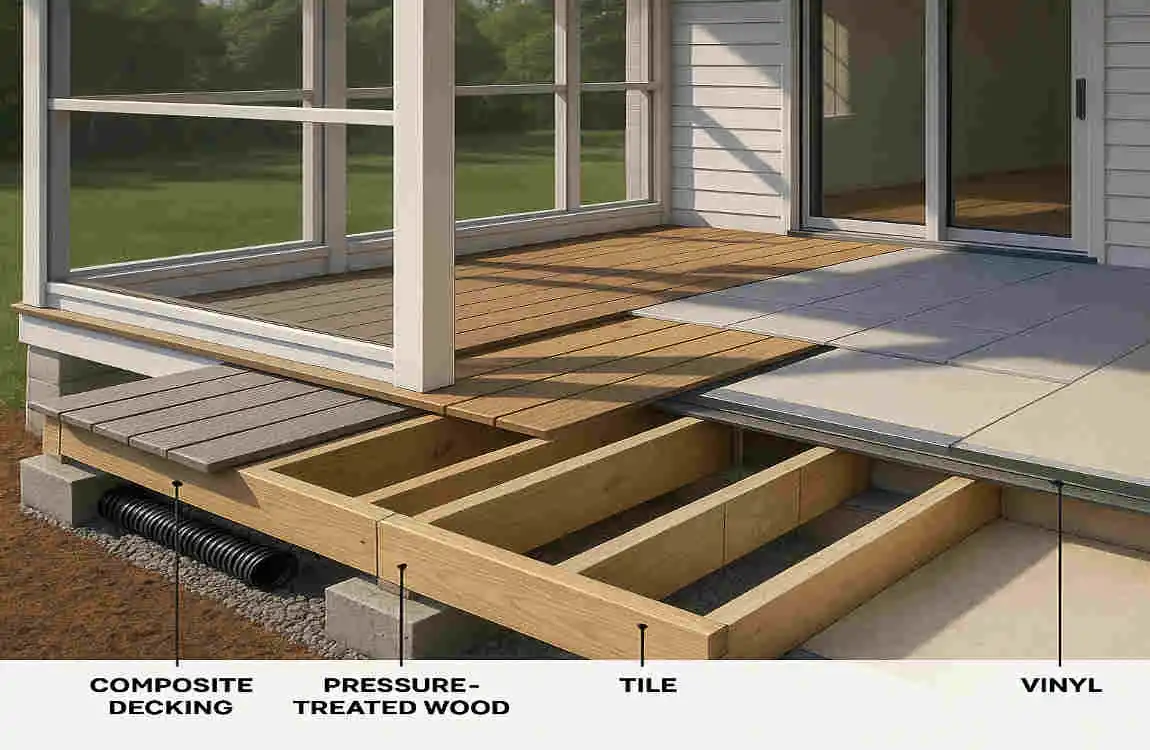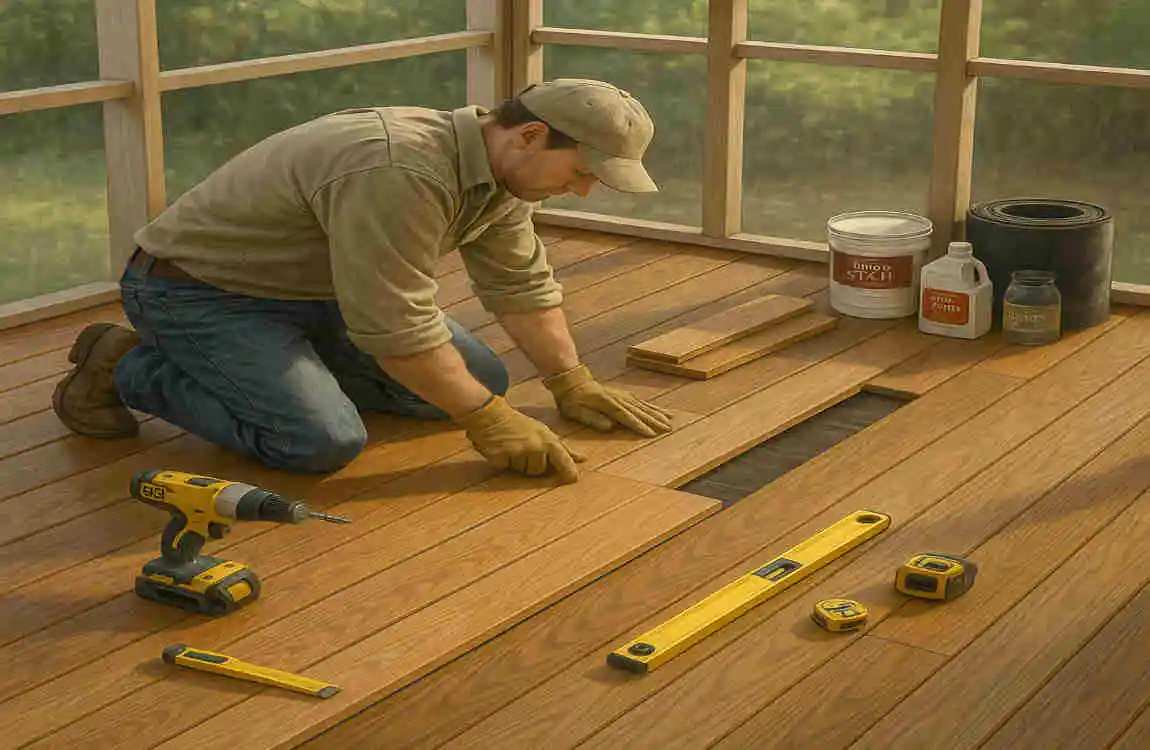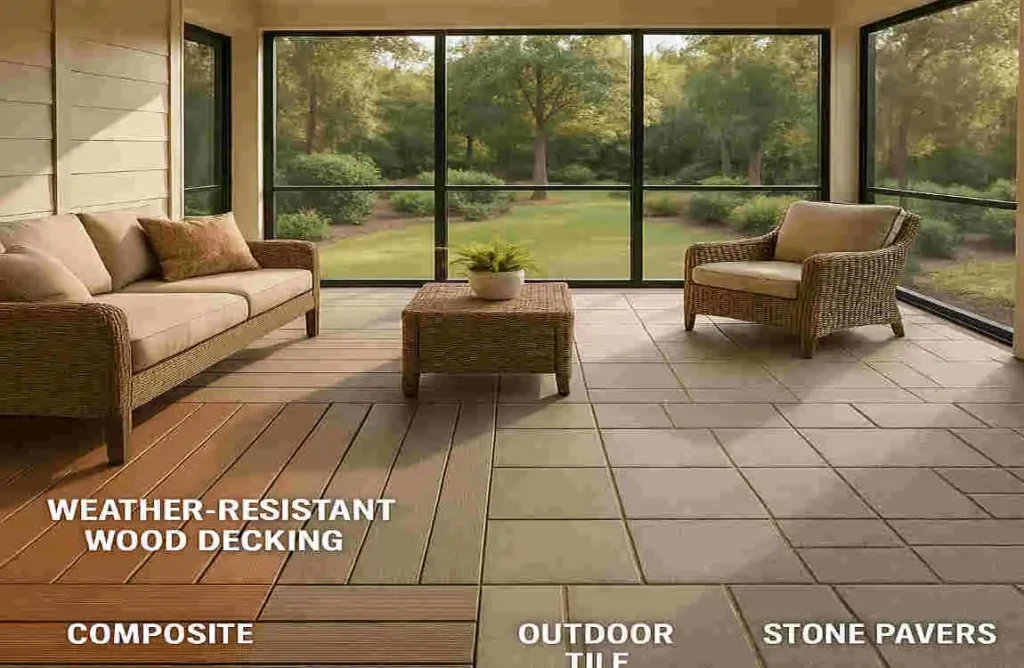Imagine stepping out onto your screened porch on a warm summer evening, coffee in hand, ready to unwind. That space isn’t just an extension of your home—it’s a bridge between indoor comfort and the great outdoors. But here’s the catch: choosing the wrong flooring can turn that dream spot into a maintenance nightmare. That’s why many homeowners ask, What’ What is the best flooring for a a screened porch? ‘ It’s a smart question, and we’re here to break it down for you.
A screened porch offers protection from bugs and some weather, but it’s still exposed to rain splatters, humidity, temperature swings, and foot traffic. Pick the right flooring, and you’ll enjoy years of durability, eye-catching style, and cozy comfort. Get it wrong, and you may encounter warping, slipping, or constant maintenance. Think about it—your porch flooring needs to handle everything from kids running around to afternoon rain showers without losing its charm.
Understanding Screened Porch Flooring Needs

First things first: What exactly is a screened porch? Picture a covered outdoor area enclosed by screens, designed to keep out insects while allowing fresh air to circulate. It’s like a sunroom but more open to the elements. Unlike a fully indoor space, it’s partially protected—rain might splash in, wind carries dust, and humidity sneaks through. But it’s not as exposed as an open deck, so your flooring gets some shelter.
These unique conditions present challenges for your flooring. Moisture from rain or morning dew can seep in, leading to mold or rot if you’re not careful. Temperature fluctuations—hot days to cool nights—cause materials to expand and contract. And don’t forget foot traffic, furniture drags, and occasional spills from barbecues.
So, what key factors should you consider? Start with moisture resistance. You need something that shrugs off water without warping or staining. Durability comes next—will it withstand daily use without cracking or fading? Comfort matters too; you want a surface that’s pleasant to walk on, not icy cold or blazing hot.
Maintenance is a biggie. Who wants to spend weekends scrubbing? Opt for low-effort options that clean up easily. Style ties it all together—does it match your home’s vibe, from modern minimalism to cozy cottage?
One often-overlooked must-have is non-slip surfaces. Wet leaves or a quick shower can make things slick, so textured materials prevent slips and falls. And handling weather fluctuations? Materials that breathe or flex with changes last longer.
Let’s break it down further. In humid climates like the Southeast, moisture resistance is non-negotiable to avoid mildew. For colder areas, freeze-thaw cycles demand tough materials that won’t crack. High-traffic porches require extra durability, while low-traffic ones can prioritize aesthetics.
As a homeowner, you play a crucial role here. Ask yourself: How do I use my porch? Is it a play area for kids, a quiet reading nook, or an entertaining spot? Your answers guide the choice.
To make it more straightforward, here’s a quick bulleted list of priorities:
- Moisture Resistance: Essential to fight dampness and prevent damage.
- Durability: Handles wear, UV rays, and impacts.
- Comfort: Soft underfoot, temperature-neutral.
- Maintenance: Easy to clean and repair.
- Style: Complements your home’s design.
- Safety: Non-slip for wet conditions.
- Weather Handling: Adapts to temperature fluctuations, including heat, cold, and humidity changes.
Considering these, your porch remains both functional and beautiful. Ignore them, and you may regret it when repair bills accumulate. Ready to explore options? Let’s move on to popular choices and compare them.
Popular Flooring Options for Screened Porches
Diving into specifics, we’ll cover six top contenders for your screened porch. Each has pros, cons, and tips tailored to real-life use. Remember, the best pick depends on your needs—consider your budget, climate, and personal style. Let’s get into it, option by option.
Hardwood Flooring
Hardwood brings that timeless, natural charm to your porch. It’s like inviting the forest indoors, with grains and colors that add warmth. Imagine oak or maple underfoot—feels inviting, right?
Pros shine bright: The natural look blends seamlessly with outdoor vibes, offering a cozy, upscale feel. It provides warmth, insulating against cool evenings, and is available in various finishes, such as stained or sealed, for customization.
But cons exist. Water damage is a risk—rain splashes can cause swelling or rot if not sealed properly. Maintenance needs are higher; you’ll need to reseal it annually to protect it.
For screened porches, choose hardy types like teak or ipe. These tropical woods naturally resist moisture, thanks to their oils. Avoid softer pines that warp easily.
Installation tip: Use pressure-treated sub house floors for extra protection. With proper care, hardwood can last 10-20 years in this environment.
Composite Decking
If low-fuss is your goal, composite decking steps up. Made from recycled plastic and wood fibers, it’s engineered for outdoors.
Pros include top-notch weather resistance—it won’t rot, splinter, or fade like real wood. Low maintenance means occasional hosing off, no staining required. It’s long-lasting, often warrantied for 25+ years.
Cons? It has a higher upfront cost, and it lacks the ultra-natural texture of wood, feeling more like plastic underfoot.
In rainy areas, this shines—water beads off without soaking in. You might love how it stays cool in the summer sun.
Tile Flooring
Tiles offer versatility and a clean, modern edge. Think patterned ceramics, turning your porch into a stylish retreat.
Pros: Super water-resistant, perfect for splashes. Styles vary from sleek subway to rustic stone-look, easy to clean with a mop.
Cons: The surface can feel cold or slippery when wet, and grout lines require scrubbing to prevent grime buildup.
Best materials? Porcelain trumps ceramic—it’s denser, less porous, and frost-resistant. Go for textured surfaces to boost grip.
For porches, large-format tiles minimize grout, reducing maintenance. They handle UV well, maintaining colors that are vibrant and accurate.
Concrete Flooring
Concrete is the tough guy of flooring—simple, sturdy, and customizable.
Pros: Very durable, standing up to heavy use without flinching. Customize with stains, stamps, or overlays to achieve a brick or wood-like appearance.
Cons: It can be hard underfoot, which may tire your feet, and it can crack due to settling or freezing.
Tips for finishing: Seal it with epoxy for water resistance. Stamped concrete adds texture and style—try a wood-plank pattern for warmth.
In hot climates, light stains keep it cooler. It’s budget-friendly for large porches.
Outdoor Carpet and Rugs
For softness, outdoor carpet or rugs deliver comfort that rivals an indoor room, all outdoors.
Pros: High comfort—cushy for bare feet, adds warmth on chilly days. Easy to replace sections if damaged, and affordable.
Cons: Shorter lifespan (5-10 years), and it can trap moisture, potentially leading to mold if not properly drained.
Look for materials like polypropylene or olefin—they’re synthetic, quick-drying, and fade-resistant. Marine-grade options work best for porches.
Layer rugs over hard floors for flexibility. Vacuum regularly, and roll them up in winter.
Vinyl Flooring
Vinyl is the practical all-rounder—affordable and versatile, mimicking a wide range of materials.
Pros: Fully waterproof, excellent for wet zones. Cost-effective, with a design that mimics the look of wood, stone, or tile. Variety means endless styles.
Cons: Can fade in direct sun or dent from heavy furniture; feels less natural than wood.
Best types for porches: Luxury vinyl planks (LVP) with UV protection. Sheet vinyl is seamless and easy to install.
It’s DIY-friendly—click-lock systems snap together. In humid spots, it won’t swell like wood.
Each option has its place. Which one calls you? Consider the exposure of your porch and how you plan to use it.
Comparing Flooring Options: What Is the Best Flooring for a Screened Porch?
Now that we’ve explored the options, let’s compare them side by side. This helps answer what the best flooring for a screened porch is based on your situation. We’ll start with a handy table, then discuss suitability, provide tips, and explore scenarios.
Flooring Type Durability Maintenance Comfort Cost Aesthetic Appeal Weather Resistance
Hardwood Medium High High Medium to High High Medium
Composite Decking High Low Medium High Medium High
Tile High Medium Medium Medium High High
Concrete Very High Low Low Low to Medium Medium Very High
Outdoor Carpet Low to Medium Medium to High High Low Medium Medium
Vinyl Medium Low Medium Low to Medium Medium Medium
See how they stack up? Hardwood wins on comfort and appearance, but requires more maintenance. Concrete is a durability beast, ideal for budget-conscious individuals, although it’s not the most comfortable.
Suitability hinges on climate. In wet, humid areas like Florida, opt for high weather resistance materials like composite or tile—they repel moisture. For dry, sunny spots like Arizona, vinyl or concrete holds up without fading much. Cold winters? Avoid outdoor carpet, as it might freeze and crack; opt for sealed concrete or porcelain tile instead.
Usage matters too. High-traffic porches with kids or pets need durable picks like composite to resist scratches. If it’s a relaxation zone, prioritize comfort—hardwood or carpet feels inviting. Aesthetics? Tile or hardwood elevates the style for entertaining, while vinyl offers affordable versatility.
Decision-making tips: Start by assessing your budget—consider low-cost options like vinyl or concrete for starters. Measure your porch and evaluate the ease of installation. Test samples in your space to see how they feel. Consider eco-friendliness; composites often use recycled materials.
Homeowner scenarios bring this home. Picture Sarah in rainy Seattle: She chose composite decking for its low maintenance and high resistance—perfect for her frequent gatherings without constant worry. Or Mike in snowy Michigan: He went with stamped concrete, sealed tight, for unbeatable durability through freezes. What about you? If your porch sees light use in a mild climate, vinyl’s waterproof ease might be your winner.
No single “best” exists—it’s about balance. Weigh these factors, and you’ll land on the ideal choice. Still unsure? Chat with locals who’ve done it.
Installation and Maintenance Tips for Screened Porch Flooring

Installing flooring on your screened porch isn’t rocket science, but doing it right ensures longevity. Start with a solid base—check for level subfloors and good drainage to avoid pooling water. Hire pros if you’re not handy; mistakes like poor sealing lead to significant issues.
For most types, acclimate materials to your porch’s temperature for a day or two before installing. This prevents warping. Use weatherproof adhesives or fasteners—such as rust-resistant screws for decking, for example.
Maintenance keeps things fresh. Seasonally, inspect for damage in spring and seal cracks before winter. In the fall, rake leaves to prevent moisture buildup.
Cleaning varies by type. For hardwood, sweep and mop with gentle soap; reseal yearly. Composite? Hose it down—no chemicals needed. Tile requires grout scrubbing with a mild cleaner. Concrete? Pressure wash annually. Outdoor carpet: Vacuum and spot-clean stains. Vinyl: Wipe with vinegar water.
